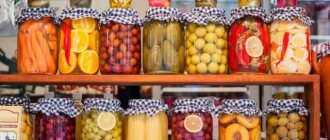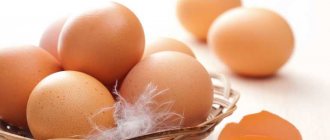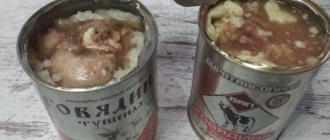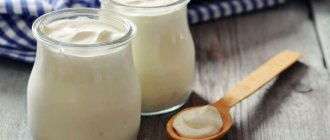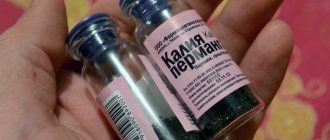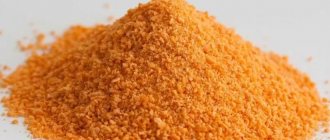Applesauce is one of the first to be introduced into a baby’s diet after vegetable puree and cereals. Apples contain healthy dietary fiber, pectin, sugars and minerals - potassium, calcium and iron. Applesauce rarely causes allergies, is well absorbed, and helps intestinal function. It is very important for parents that the new complementary feeding dish is safe, of high quality and tasty. Roskontrol experts tested applesauce from seven popular brands at prices ranging from 16 to 60 rubles per jar and found out how they differ from each other, which puree is the sweetest and which contains the most vitamin C.
For examination, purees produced in Russia, Poland, the Czech Republic and Italy were purchased: “Frutonyanya”, “Babushkino Lukoshko”, Hipp, Gerber, “Gardens of Pridonya”, Nutricia, Heinz
. The examination was carried out jointly with the All-Russian Scientific Research Institute of Canning and Vegetable Drying Industry (VNIIKOP).
Recommended products for first feeding
Usually, the baby tries the first adult foods when he reaches four months. WHO recommends postponing this event until six months of age, but parents still decide, focusing on the health and needs of their baby. Vegetables are the first to be introduced into a child’s diet. And not just any, but those that are easily digestible and do not cause allergies. Such vegetables include zucchini, broccoli, zucchini, cauliflower, and potatoes. All these vegetables are introduced one by one, starting with very small portions, gradually increasing the volume.
The product is usually given for the first time in the morning, and then the child's reaction is observed. And if everything is in order, the next day the proposed volume is increased. The body needs time to adapt to a new product, usually about a week.
Criterias of choice
Canned purees are prepared in accordance with the needs of the child’s body at a particular age. During production, all jars undergo more than one quality control, so you should not be afraid of store-bought children's products. However, the choice should be taken carefully.
What to look for when buying baby puree?
- Price. Expensive does not equal best. After all, the price includes not only the costs of producing high-quality products, but also such factors as: product design, advertising costs, logistics and others.
- Compound. It is important that preservatives, flavor enhancers and artificial colors are not used in baby food. It is better to buy products without salt, sugar and soy. Any other spices are not allowed. Ideally, a high-quality puree contains two ingredients: water and the main product.
- Age. All jars indicate the age at which it is permissible to use purees from a particular product in the children's diet. These recommendations should be taken into account because the ability to digest certain vegetables and fruits appears at different times.
- Product quality. When choosing ready-made purees, parents should pay attention to the consistency. The ingredients must be sufficiently crushed. It is also important that the packaging indicates that the product is hypoallergenic. The shelf life of a quality product is no more than two years. And after opening, the contents can be stored for 1-2 days in the refrigerator.
- Package. The jar must be hermetically sealed. A characteristic pop when opening the can will tell you about this. The integrity of the packaging is also important; it should not be wrinkled or otherwise damaged.
The importance of proper storage of baby food
All children need warmth, care and attention. But the child is gradually growing, and he needs a varied diet. And here the question arises: is it possible to save the prepared product until the next feeding? Here it is important to pay attention to the fact that the child’s immune system is not yet strong enough, so special attention should be paid to the storage of baby food products. The well-being and health of the baby often depends on the conditions in which they are kept and how long they are kept.
How to choose puree for the first feeding
The baby's readiness to introduce complementary foods is indicated by a doubling of body weight from the moment of birth, as well as the ability to eat while in an upright position. Then the question arises about which purees are best to buy for the first complementary feeding. Pediatricians recommend starting with vegetable purees, since they do not contain fructose, which has an undesirable effect on the immature pancreas and kidneys.
Doctors advise choosing products from well-known, trusted brands, as they are subject to quality control procedures. Thus, when experts compiled a review of puree companies for first feeding, the following factors were considered:
- Price. The most expensive products do not mean the highest quality. The price is affected by the type of packaging, the cost of delivering raw materials - something that does not affect the contents;
- Compound. A quality product does not contain dyes, enhancers, preservatives, or spices;
- Hypoallergenicity and safety of the product;
- Degree of grinding of components;
- Age category.
When buying baby puree, look at the integrity of the packaging; the lid should not be damaged, and when opening the package, a pop should sound, which confirms the freshness of the product. You should also find out whether the chosen diet matches the child’s age. The review presents foreign and domestic companies offering top quality products.
The best domestic purees for first feeding
Russian manufacturers produce food for children at the highest level at a reasonable price, due to which the products are in demand among parents. Many companies produce products from natural raw materials of their own production. The rating included 5 domestic manufacturers that have proven themselves to be leaders in the quality of baby food and popularity among mothers and fathers.
Frutonyanya
This brand is one of the most famous; most parents choose the products of the Frutonyan company. All products undergo special testing and are recommended by the Union of Pediatricians. Frutonyanya produces vegetable puree for the first feeding. The tightness of the packaging is ensured by a lid and thick polyethylene film, which protects the container from the penetration of dirt and dust.
The company has a continuous production cycle. Fruits and vegetables from our own farms are processed, which is an indicator of the naturalness of the products. The manufacturer has released a line in doy-pack packaging, now you can take food for a walk.
Advantages:
- No added salt or sugar;
- Quality testing;
- Low cost;
- A scale with divisions in grams allows you to see the amount of puree your baby has eaten;
- Availability of hypoallergenic series
Flaws:
- Not identified.
Consumer reviews highlight the low risk of allergies after use, since the product does not contain preservatives. For buyers, an important condition is the experience of the manufacturer. The products are produced by factories that have specialized in baby food for decades.
Grandma's basket
The company's products are not as advertised as Frutonyanya, but are still in demand among many buyers. The puree meets strict conservation purity conditions. During the manufacturing process, technologies are used to preserve the beneficial properties of products. The puree contains only boiled and pasteurized fruits and vegetables. The composition consists of the main ingredient and pure water.
There is a choice of purees for the first feeding from zucchini, broccoli and cauliflower. The company also produces fruit products. For older children, you can purchase food from cod, pink salmon and salmon. The puree has the right thickness.
Advantages:
- Does not contain food colorings or other additives;
- Possibility to buy in soft drinking packaging;
- Environmentally friendly components;
- Uniform consistency.
Flaws:
- Unusual taste.
One-component purees of this brand are in particular demand among buyers. They note the good consistency and optimal quantity per serving. Not all parents like the smell of the product, but it does not bother their children, and they eat the puree with great pleasure.
Swaddle
I launched this brand not long ago. The manufacturer produces nutritional formulas for children of different ages. The consumer can choose purees from fruits, vegetables or a combination. The product is presented in different containers - glass and cardboard.
The main ingredients are represented by fruits and vegetables, while the company itself is engaged in growing crops. No GMOs, dyes or preservatives are used to make the products. The composition contains only natural products and water. And the quality of the indicators is controlled by the Russian Academy of Medical Sciences. The absence of transportation costs for purchased raw materials allows us to reduce costs, which cannot but attract.
Advantages:
- Large selection of purees for children from 4 months;
- Production on high-precision equipment;
- Convenient packaging;
- Affordable rates.
Flaws:
- Use of sugar for some types of purees.
Users are attracted by the large selection. In addition to purees, you can purchase fruit drinks, juices and cereals. High demand for purees made from several components. These can be fruits or berries with the addition of fermented milk products.
Subject
The concern occupies a leading position among domestic manufacturers of baby food. Products are made using the latest equipment. The Tema brand offers compositions with fruits, vegetables, meat, and combined variations. Vegetable compositions from zucchini, carrots and pumpkin are suitable for complementary feeding.
During the manufacturing process, only natural and easily digestible vegetables are used, which normalize the functioning of the digestive system. In addition to purees, the company produces juices and fermented milk products.
Advantages:
- Affordable prices;
- High quality products;
- Huge assortment;
- Variety of packaging.
Flaws:
- Using a small amount of starch.
Many people like that Tema puree can be bought both at the nearest store and at the pharmacy. The ideal consistency and the absence of unnecessary inclusions were also noted. Vegetable puree has a pleasant smell and color. Often there are promotions on Tema puree in supermarkets.
About the safety of baby food products
In the Russian Federation there is a whole regulation on food safety for children - that’s what it’s called. This document sets requirements for manufacturers and sellers of children's products related to the protection of children from toxic and chemical substances. This concerns not only baby food produced in our country, but also imported from abroad. That is why, when buying baby formula, porridge, puree or other product, you can be sure of its quality and safety. The regulation requires not only proper production, but also packaging, storage of baby food and its disposal:
- Children's products are sold only through special stores or dedicated departments of supermarkets (therefore, it is better to buy them there or, in extreme cases, at a pharmacy).
- Expiration dates are set by the manufacturer, who is fully responsible for the quality of their product.
- Transportation of baby food is carried out in accordance with the requirements of technical regulations for the transportation of any products.
At the same time, when producing baby food, a number of conditions must be observed:
- Do not use curd products with high acidity.
- Do not add soy flour or grains contaminated with foreign matter.
- By-products are prohibited, with the exception of tongue, liver, heart and blood.
- Do not include beef with a fat content higher than 12%, pork - 32%, lamb - 9% in baby food.
- Do not use salted butter or products with a fat content below 82%*.
You can view the full list of products prohibited in the production of baby food by following the link attached to the article.
What to look for when choosing purees for your baby
Types of purees:
Vegetable purees are recommended by pediatricians for first feeding.
Such purees are rich in vitamins, minerals, and healthy acids. Vegetables have a beneficial effect on the digestive system of babies. For the first feeding, neutrally colored vegetables are used - zucchini, broccoli, cauliflower, zucchini. Later - carrots, pumpkin. Peas and potatoes are introduced no earlier than 8 months, when the baby’s gastrointestinal tract has already adapted to complementary foods. Fruit purees are usually introduced after the first vegetable complementary feeding. Fruits with low allergenicity are apples (green and white), pears, plums, apricots. It is preferable to introduce seasonal fruits characteristic of the area. Closer to the year, you can introduce berry purees.
Meat purees - introduced after vegetables and fruits. The first meat for a child is chicken, turkey and rabbit. Later - beef. It is recommended to introduce lean pork last.
Fish purees - introduced no earlier than a year. It should only be low-fat sea fish - hake, pollock, cod (types of fish with “white” meat). It is important to remember that fish is quite an allergen, so it must be administered with caution.
Compound:
For the first complementary foods, you need to choose one-component purees. The composition may contain water, vegetable oil. Choose purees without sugar, salt, preservatives, thickeners, flavors and dyes. All these components are harmful to the child's body. Some manufacturers use rice flour or rice starch as a natural thickener. They have a binding effect and can cause allergies.
Manufacturer:
Well-known manufacturers take care of their name and monitor the quality of their products. Many of them have a line of organic baby food and international quality certificates.
Package:
The best container for baby purees is glass. It preserves the quality of the product as much as possible. You can check whether the storage conditions for the puree were met - when you open the jar, you should hear a pop. Food in iron cans has the longest shelf life. Cardboard packaging is affordable. Well, the soft packaging is convenient for snacking on the street or for a child to eat on his own.
Popular questions about baby puree
When should you start introducing the first complementary foods?
Baby food manufacturers offer zucchini puree as the first complementary food from 4 months. Sometimes there are cereals and juices that can be consumed from 4 months. Pediatricians recommend introducing the first complementary foods from 6 months, and before that, feeding the baby milk. Dr. Komarovsky talks about this in more detail in his video.
How to make your own zucchini puree for first feeding?
Peel the washed zucchini and cut into cubes. Next, place it in a stainless saucepan and fill with cold water. After boiling, cook for 10 minutes and then drain the water. Grind the cooked zucchini in a blender until smooth, then cool to room temperature before feeding the baby.
When can you give your baby mashed potatoes?
From the age of 8 months, potatoes can be introduced into the child’s diet.
But it is advisable to start your acquaintance not with puree, but with vegetable broth. Afterwards you can add mashed potatoes. To help parents organize their child's nutrition, Philips AVENT published an article on its website with the stages of introducing complementary foods. From it you will learn at what age you can start giving your baby certain products according to the recommendations of experts.
How to make your own applesauce?
It is better to take green or white apples - they are less allergenic. You need to peel the washed apples, remove the core and tails. Boil apples in a stainless saucepan until tender. Decant the water and grind the apples in a blender until smooth, cool to room temperature.
What can you make from baby fruit puree?
Can be added to cottage cheese, used as a sweet sauce for children's baked goods. Also, based on fruit puree, children's muffins, cookies, and cupcakes are baked, which can be given to older children.
What purees are best for first feeding?
For the first feeding, one-component purees are used. Start by introducing green vegetables - zucchini, broccoli. Next - cauliflower, parsnips, zucchini, pumpkin.
Rules for storing food of different types
Undoubtedly, breast milk is the most valuable and beneficial for a child. But there are situations when a mother needs to leave home and she expresses milk in order to feed the baby on time. In addition, the child grows and over time he needs complementary feeding. Expressed breast milk, infant formula for formula-fed babies and complementary feeding products require a special approach, and it is very important to know the conditions and shelf life of baby food.
- Expressed breast milk should be stored in special containers, which can be bottles, cups, containers or bags made of plastic, glass and plastic. The container must be sterile, airtight, easy to use, preferably with a measuring scale. Fresh expressed milk cannot be stored at room temperature 19–22 °C for more than 10 hours, 22–25 °C for 4–6 hours, above 25 °C for up to 3 hours and no longer. Breast milk can be stored in the refrigerator for 24 hours, and in the freezer for up to 3-4 months, depending on how often the door is opened.
- Dry mixtures and cereals, provided the packaging is intact, are designed for a long storage period. Their packaging in production is carried out in a special nitrogenous environment to prevent contamination by microorganisms.
- Baby formulas and cereals packaged in a bag and additionally in a cardboard box must be stored in their original packaging. Do not pour into plastic or glass containers to avoid microbial or other contamination.

